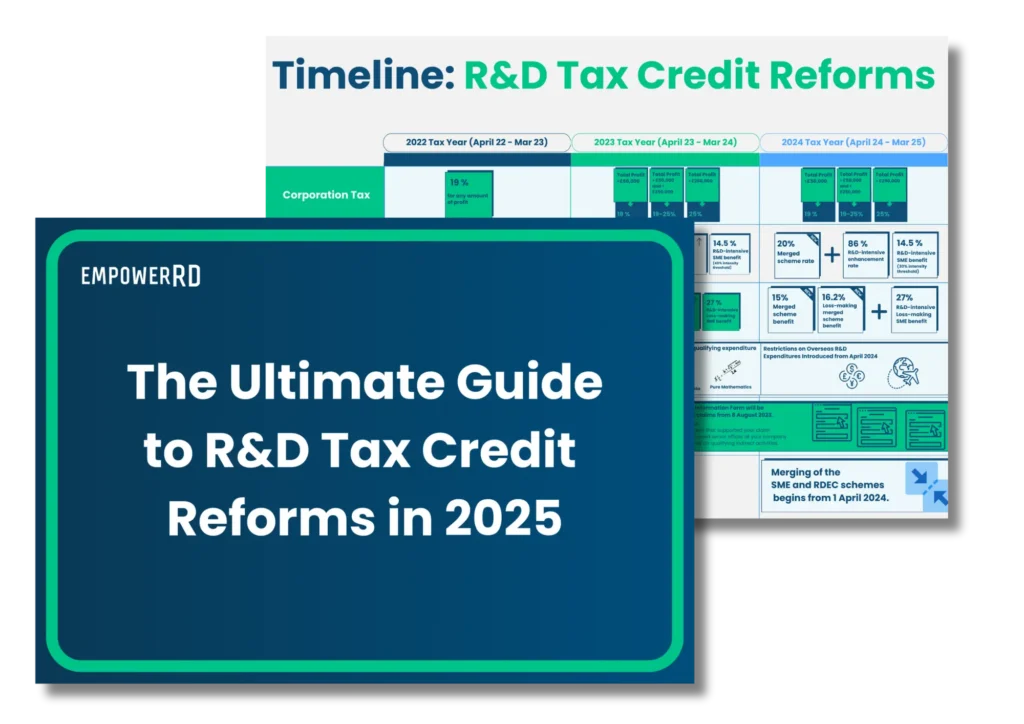In the wake of economic challenges, HMRC’s recent release on R&D tax credits for the tax year 2021-2022 offers a hopeful narrative on UK businesses’ resilience and innovative spirit. Especially compared to last year’s stats.
A resounding rebound in R&D tax relief support
Amidst the global upheaval caused by the COVID-19 pandemic, the R&D tax relief landscape has demonstrated remarkable adaptability and resurgence. The data tells an intriguing story:
R&D tax relief support across all claimants
SME Scheme: Demonstrating resilience, it marked a 1% elevation in 2021, growing from £4.15 billion to £4.2 billion, and impressively leapt by 14% in 2022, culminating at £4.8 billion.
RDEC Scheme: After a marginal 4% setback in 2021, falling from £2.7 billion to £2.6 billion, it rose with an 8% boost in 2022, reaching £2.8 billion.
Overall: The combined R&D tax relief support dipped slightly by 1% in 2021—from £6.9 billion in 2020 to £6.8 billion. However, it displayed a robust recovery with a 12% increase in 2022, reaching £7.6 billion.
This trajectory underscores not only economic recovery but also how businesses are embracing innovation. It emphasises the vital role of R&D tax relief in fostering entrepreneurial growth.
Breakdown of R&D tax relief support
R&D expenditure: A story of resilience and rebirth
This year, R&D spending reached an impressive £44 billion, highlighting a journey of robust recovery despite global challenges.
RDEC Scheme: Peaked at £23.7 billion in 2020, then declined to £21 billion in 2021. However, with renewed vigour, it rose to £22.4 billion in 2022.
SME Scheme: Consistently making progress, it rose from £14.4 billion in 2020 to £15.6 billion in 2021, further escalating to £17.8 billion in 2022.
Overall R&D: After a promising £42.9 billion in 2020, there was a temporary dip to £40.6 billion in 2021. Nonetheless, 2022 saw not just a revival but a dynamic 8% increase from the previous year.
The temporary setback in 2021, especially within the RDEC scheme, was quickly offset by a strong recovery in 2022. This fluctuating journey shows that businesses have deftly adapted in the post-pandemic era. This revival underscores the crucial value of R&D tax relief as a catalyst for innovation and a driver of economic prosperity.
Note: The current data is provisional and subject to refinement in the coming year.
R&D expenditure
Claim dynamics: delving deeper and broadening horizons
The trajectory of R&D tax relief claims in 2022 highlights businesses amplifying their scope and innovation depth. With a 5% growth in total claims to 90,315 and a 6% increase in the average claim value, more businesses are venturing into R&D and investing more in each project. This dual expansion points to businesses innovating more effectively, a strategy designed to ensure longevity and harness new opportunities in a post-COVID landscape.
Scheme Insights:
SME Claims: A steady climb is evident in the SME sector. The number of claims rose from 73,845 in 2020 to 75,940 in 2021 and further to 79,205 in 2022. Notably, the average SME claim value surged from £55,312 in 2021 to £60,104 in 2022.
RDEC Claims: In the RDEC segment, we observe a marked growth trajectory, with claims increasing from 9,890 in 2020 to 10,450 in 2021 and reaching 11,115 in 2022. The average RDEC claim value, too, saw a steady increase, moving from £248,803 in 2021 to £252,000 in 2022.
Overall Claims: Casting a wider net, the total claims evolved from 83,735 in 2020 to 86,390 in 2021, culminating at 90,315 in 2022.
Claim dynamics overview: 2022
Claim growth by scheme over the years
Average claim value by scheme
Regional resonance: London’s allure
When analysing R&D investments across the UK from 2021 to 2022, it becomes evident that London and the South East have emerged as dominant players. London, with its global financial hub status, takes the lead by accounting for 22% of total claims and 32% of the total amount claimed in R&D tax relief. Notably, Inner London-West stands out with an increase in total expenditure from £7.1 billion in 2021 to £7.8 billion in 2022. Additionally, the amount claimed in tax relief has risen from £1.2 billion to £1.3 billion. Similarly, the South East has experienced a substantial uptick in total expenditure, soaring from £6.1 billion to £7.3 billion. The amount claimed has also jumped from £1 billion to £1.2 billion.
However, while London and the South East remain consistent in their growth, disparities are evident in the broader UK landscape. The East of England, though ranking fourth in total claims, has secured its position as the third-largest region in terms of the amount claimed. This indicates significant investments per claim. Comparatively, the total cost in the East of England has increased from £795 million in 2021 to at least £815 million in 2022. It is worth noting that while most regions have registered growth in claims and total cost, areas like Inner London – East have experienced a decrease in total expenditure from £3.5 billion to £3 billion. This suggests that even in dominant regions, R&D investments can witness nuanced fluctuations. These findings underline the importance of continuous evaluation and policy adjustments to foster and evenly distribute R&D investments across the UK.
Sectorial shifts and undercurrents
With the Information & Communication and Manufacturing sectors each making up 23% of claims, followed by the Professional, Scientific and Technical sectors at 16%, we note an unwavering push towards digitisation and technological advancement. It is worth speculating whether the pandemic may have expedited digital transformation initiatives, fuelling more R&D in these sectors.
Cost bands and fresh initiatives
While 69% of claims were within the up-to-£50k bracket, there’s a nuanced story underneath. The prevalence of smaller R&D ventures could indicate businesses are diversifying their risk, testing multiple smaller initiatives rather than committing to singular, larger ventures. The diverse range of first-time applicants across both the SME and RDEC schemes further exemplifies the dynamism of the R&D scene.
These preliminary figures, with pending claims for 2021-2022, offer a snapshot of what may come in next year’s publication. As the business landscape continues to evolve, the spirit of innovation emerges as our guiding light. Why not try out our R&D tax credit calculator to see what size your claim might be?












